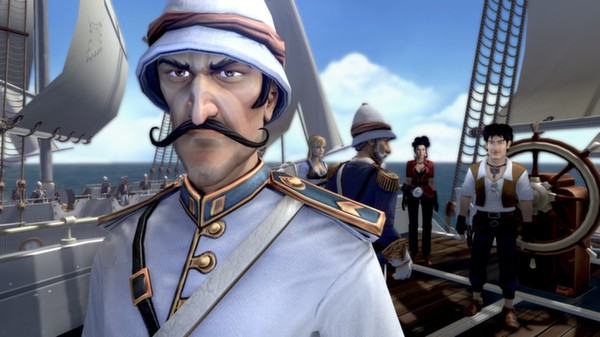Jack Keane 2: The Fire Within (Review)
This game was reviewed on the PC
Three years after Jack Keane’s adventure in the original Jack Keane game, rumours of a treasure of immeasurable value reach Jack’s greedy little ears, and he is determined to claim this fortune (called Ukumba, or the Eye of Fate) for himself. Jack Keane 2: The Fire Within is a third-person 3D point-and-click adventure game, developed by Deck13 and published by Nordic Games. Join us as we delve head first into the adventures of Jack and his crew as they journey through the Eastern Hemisphere in search of the mysterious Eye of Fate.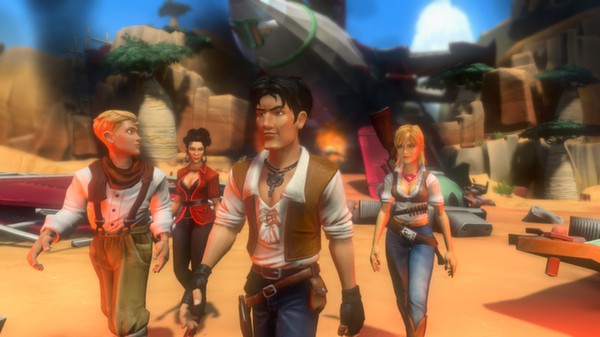
It’s 1899 in Shanghai, and Jack has been captured, imprisoned, and thrown into a cell with an African Shaman for a cellmate. As luck would have it, this Shaman happens to be exactly who Jack is looking for, as he is the only person who possesses the knowledge of the whereabouts of Ukumba. After gaining the Shaman’s trust, Jack finally gets the locations of the artifact fragments needed to unlock Ukumba via a ritual that allows the Shaman to imbed the information into Jack’s subconscious. Conveniently, the Shaman dies right before explaining how this knowledge transfer works, stating it would be a difficult journey “but [Jack] can do it, provided [he] gnaaAAAhrggg….” It can be assumed that this happened because of the intense power needed to transfer the Shaman’s memories to Jack, though it is still unclear. If the Shaman succeeded is also unclear. If you are confused about this sudden plot turn, prepare yourself for many more holes and plot jumps throughout the game that are never explained.
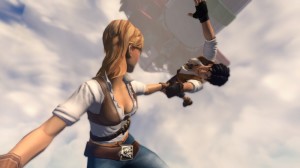 In contrast to the occasionally erratic storyline, the character development of Jack and his companions is very in-depth and creates the push that players will need to move forward in the game. Jack’s main companion is Amanda, a gun-toting blonde who appeared in the original Jack Keane as a bounty hunter who was hired to capture Jack for the evil scientist Dr. T, but ended up falling for Jack’s charms. There will be times when the game forces you to play as Amanda (for instance, when breaking Jack out of prison), which helps relieve any monotony that you might encounter playing as Jack. Furthering the romantic confusion, a new love interest, Eve, comes aboard as another companion and adds a new dynamic to the team. Can Jack handle two women competing for his attention, and will he even want to once everything is said and done?
In contrast to the occasionally erratic storyline, the character development of Jack and his companions is very in-depth and creates the push that players will need to move forward in the game. Jack’s main companion is Amanda, a gun-toting blonde who appeared in the original Jack Keane as a bounty hunter who was hired to capture Jack for the evil scientist Dr. T, but ended up falling for Jack’s charms. There will be times when the game forces you to play as Amanda (for instance, when breaking Jack out of prison), which helps relieve any monotony that you might encounter playing as Jack. Furthering the romantic confusion, a new love interest, Eve, comes aboard as another companion and adds a new dynamic to the team. Can Jack handle two women competing for his attention, and will he even want to once everything is said and done?
Dialog choices available in the game are as devious as they are entertaining. At times, you will be forced to say things that are rude and obnoxious to get the reactions you need, while other times (especially when talking to your companions) you will want to, but it could be harmful to Jack’s well-being to do so. The way you determine the appropriate choices are situational; you are tempted with options like asking a German harbourmaster if he wants to hear a joke, then having the option to ask him, “What’s the difference between a sailing ship and your wife?”
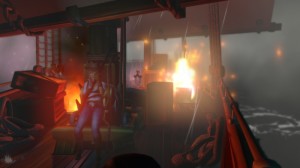 Telling a bunch of rioting prisoners behind bars that they’re all wimps so they throw shoes at Jack, which are needed to trade in for knowledge from another prisoner, is convenient, but players will have to fight the urge to step over the line in every situation, lest it end with a ticked off companion or a game over and a trip back to the title screen.
Telling a bunch of rioting prisoners behind bars that they’re all wimps so they throw shoes at Jack, which are needed to trade in for knowledge from another prisoner, is convenient, but players will have to fight the urge to step over the line in every situation, lest it end with a ticked off companion or a game over and a trip back to the title screen.
Furthering the mentality that players should be trying to think like the protagonist, whenever Jack is knocked out in the story, he enters his subconscious. You’ll recall that this is where the Shaman hid the secrets to locating all the artifact pieces needed to obtain the Ukumba. Unfortunately, Jack has hidden so many dark secrets and insecurities in his own subconscious that he must fight himself and his memories in order to get to the Shaman’s knowledge. This means that our sarcastic and seemingly fearless Jack will have to face his own fears each time he is knocked out, which adds to the depth in his character and pulls players further into the story.
While you’re moving around the game, you’ll notice that it’s not your typical point-and-click format. The game allows players to move freely about the room with the WASD keys and use the space bar to jump. Alternatively, you can hold down the left mouse button to move in a direction, and click the right mouse button to jump, but it’s the old tried-and-true movement keys that work best, in terms of fluidity. You will still need to use the left mouse button to examine and pick up objects or speak with people, as you normally would, however, at times the left mouse clicking is unresponsive, which can get on a player’s nerves quickly. Three or four clicks later, it will respond, or Jack will walk up to a person or object and just stand there without completing the action.
Where the game adds a new and welcome gameplay feature to the genre, however, is when you fight NPCs in a defense-then-attack type of combat. Jack will learn new defense and attack moves from NPCs along his travels, and these attacks are usually necessary for the next fight that he encounters. When in combat, cards with pictures of the moves appear at the bottom of the screen, with a timer bar that shrinks, giving you only a few seconds to find and select the move that you want to perform. Once a move is selected, Jack will replicate it and either win or lose against the opponent. If Jack loses, players will get a chance to fight the NPC again until they win, so while there is no indication of what moves to use based on your enemies’ movements, you can play several times over, if need be.
One of the most important aspects of a video game is how well the audio and visual content comes together to create an illusion both immersive and unique. The Fire Within uses believable voice actors and upgraded graphics from its predecessor to create an enjoyable atmosphere for its players. The only downside to this is when they do not mix properly, and end up creating a disjointed experience. Often in the game, many of the NPC reactions in cutscenes don’t match the vocal tones or situations. When an actor sounds surprised or is inquisitive, much of the time, you won’t see that reflected visually. There are also moments when what is going on around the characters is much more exciting than their reactions would have you believe (like a cannon being fired, and the NPCs not even batting an eye). That being said, the actors in the game have a diverse selection of accents to help give the game its worldly feel. From German and American, to British and African, there are so many types of characters lending their unique voices that it’s hard not to feel like you’re travelling around the globe!
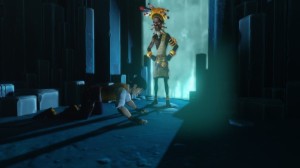 To complement this diversity, the number of different types of scenes and locations help to further this adventure. Everything from the bright German port with its soft sunset lighting and its random assortment of boxes, to the icy and unwelcoming inside of Jack’s subconscious, the scenery is diverse and constantly changing in The Fire Within. The game uses cel-shading and a cartoony art style that still tries to add a little realism to its characters. The entire layout is 3D, so Jack can move around every scene freely, though the camera angles need a little work. There is also no way to rotate the camera as it’s still laid out like a point-and-click adventure in that sense. This makes for uncomfortably awkward movements and easily missed clues, since jumping or moving from one side of the room to the other does not reveal the entire room properly, and you can’t pan out so that every corner can be seen. The camera also changes direction in attempts to be artistic and to suit the type of scene that you enter, but this only adds to the frustration. Even still, the game’s exploration aspect is much richer than most point-and-click adventures, adding scenes that you can explore on so many different levels.
To complement this diversity, the number of different types of scenes and locations help to further this adventure. Everything from the bright German port with its soft sunset lighting and its random assortment of boxes, to the icy and unwelcoming inside of Jack’s subconscious, the scenery is diverse and constantly changing in The Fire Within. The game uses cel-shading and a cartoony art style that still tries to add a little realism to its characters. The entire layout is 3D, so Jack can move around every scene freely, though the camera angles need a little work. There is also no way to rotate the camera as it’s still laid out like a point-and-click adventure in that sense. This makes for uncomfortably awkward movements and easily missed clues, since jumping or moving from one side of the room to the other does not reveal the entire room properly, and you can’t pan out so that every corner can be seen. The camera also changes direction in attempts to be artistic and to suit the type of scene that you enter, but this only adds to the frustration. Even still, the game’s exploration aspect is much richer than most point-and-click adventures, adding scenes that you can explore on so many different levels.
Jack Keane 2: The Fire Within adds exploration, adventure, and comedy into a genre that can sometimes feel a little slow-paced. Logical puzzles and witty commentary are what gives this game its endearing quality, and it is an adventure that can stand alone even if you haven’t played the original Jack Keane storyline. Fans of the series won’t be disappointed with Nordic Games’ choice to approach Deck13 and breathe new life into their old friend Jack and his comrades.
About This Post
